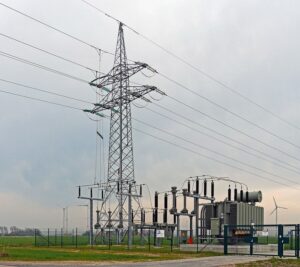 A real-time thermal rating system has been developed initially for overhead transmission lines using actual meteorological data and real-time conductor temperatures and line loadings. Such a real-time thermal rating system provides much higher ampacity ratings than other conventional methods. A natural convective heat equation is developed for stranded conductors. The temperature of the conductor is solved directly without resorting to an iterative solution.
A real-time thermal rating system has been developed initially for overhead transmission lines using actual meteorological data and real-time conductor temperatures and line loadings. Such a real-time thermal rating system provides much higher ampacity ratings than other conventional methods. A natural convective heat equation is developed for stranded conductors. The temperature of the conductor is solved directly without resorting to an iterative solution.
The temperature of an asset itself, such as a power cable, is a key for a real-time thermal rating system. This can be measured continuously if equipment utilizes a distributed temperature sensing (DTS) system. Distributed temperature sensing optical fibers are installed along with the fiber cable. The fiber cable can also be utilized for telecoms purposes as DTS systems typically utilize standard telecoms fiber optics.
Thermal headroom typically is determined using static ratings which are based upon probabilistic methods and are representative of worst-case scenarios. The “static” design calculation methods provide simple and conservative estimates of network capacity. In reality, networks can be complex and operational ratings can be influenced by multiple factors including weather conditions and loading. Soil condition, buried depth, burial configuration, cable size, and type must be considered for underground equipment.
The real-time thermal rating system works with such assets as:
- Underground and subsea cables
Experience has shown that cable depth, soil type, and the shape of the load curve have a material impact on ratings. The real-time thermal rating system can determine actual thermal headroom indicating whether some unused network capacity can be released or locations where networks are constrained.
- Overhead lines
- Sag-based
- Tension-based
- Temperature-based
- Current rating-based
- Transformers
The real-time thermal rating systems for transformers utilize measurements including transformer load, ambient, and transformer temperatures based on the equations set out in IEC 6007. With the exception of emergency ratings, P15 recommends using an average ambient temperature and a weighted average that products the same aging if the temperature varies over a load cycle.
Optromix is a fast-growing vendor of fiber Bragg grating (FBG) products line: fiber Bragg grating sensors, FBG interrogators and multiplexers, distributed temperature sensing (DTS) systems. We create and supply a broad variety of top-notch fiber optic solutions for the monitoring of various facilities all over the world. Our main goal is to deliver the best quality fiber optic products to our clients. We produce a wide range of fiber optic devices, including our cutting-edge customized fiber optic Bragg grating product line and fiber Bragg grating sensor systems.
If you are interested in Optromix distributed temperature sensing systems, please contact us at info@optromix.com

